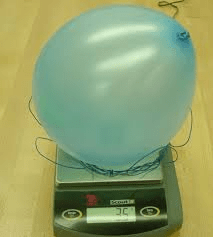Which of the following is matter?
A. Heat
B. Air
C. Light
D. Sound
B. Air
Which state of matter has a definite shape and definite volume?
A. Liquid
B. Gas
C. Solid
D. Plasma
C. Solid
What causes water to change from a liquid to a solid?
A. Adding heat
B. Removing heat
C. Adding light
D. Removing air
B. Removing heat
Which is a physical property?
A. Rusts when exposed to air
B. Burns easily
C. Has a shiny surface
D. Reacts with acid
C. Has a shiny surface
Which is a physical change?
A. Paper burning
B. Ice melting
C. Metal rusting
D. Wood rotting
B. Ice melting
A student mixes two clear liquids. The temperature of the beaker drops, and a white solid forms at the bottom. What best explains what happened?
A chemical reaction took place, forming a precipitate and absorbing energy.
Matter must have…
A. Mass and volume
B. Color and shape
C. Temperature and mass
D. Energy and sound
A. Mass and volume
Which state of matter takes the shape of its container but keeps the same volume?
A. Solid
B. Liquid
C. Gas
D. Plasma
B. Liquid
When ice melts, the change is called…
A. Condensation
B. Freezing
C. Melting
D. Evaporation
C. Melting
Which is a chemical property?
A. Melting Point
B. Density
C. Flammable
D. Colorless
C. Flammable
Which is a chemical change?
A. Water freezing
B. Sugar dissolving
C. Iron rusting
D. Ice melting
C. Iron rusting
When magnesium metal is placed in hydrochloric acid, bubbles form and heat is released. What are the two main signs of a chemical reaction in this example?
Gas formation and temperature increase
Which of these is not matter?
A. Water vapor
B. A rock
C. A shadow
D. Smoke
C. A shadow
Which state of matter has particles moving freely and far apart?
A. Solid
B. Liquid
C. Gas
D. Plasma
C. Gas
When water vapor cools and turns into liquid water, this process is called…
A. Freezing
B. Condensation
C. Melting
D. Boiling
B. Condensation
A physical property can be observed…
A. Only by changing the substance
B. Without changing the substance
C. Only after heating it
D. Only during a reaction
B. Without changing the substance
A sign that a chemical change occurred is…
A. Change in size or shape
B. Melting
C. Bubbling or gas forming
D. Evaporating
C. Bubbling or gas forming
During a lab, a student combines two substances and observes a color change but no temperature change. Which conclusion is best supported by the evidence?
A chemical reaction likely occurred.
Why is air considered matter?
A. It has no weight
B. It has mass and takes up space
C. It can’t be touched
D. It produces energy
B. It has mass and takes up space
Lightning flashes across the sky during a storm. It’s hot enough to turn air into plasma.
Which is the best explanation of why lightning is considered plasma and not another state of matter?
A. It glows and flows like a liquid.
B. It consists of charged particles that emit light and conduct electricity.
C. It has no energy or temperature.
D. It is made of solid air molecules.
B. It consists of charged particles that emit light and conduct electricity.
Which process happens when a gas changes directly into a solid?
A. Melting
B. Sublimation
C. Deposition
D. Evaporation
C. Deposition
Which describes a chemical property of iron?
A. It is magnetic
B. It is gray
C. It rusts in moist air
D. It melts at high temperature
C. It rusts in moist air
Cutting paper into smaller pieces is a…
A. Physical change
B. Chemical change
C. Nuclear change
D. Color change
A. Physical change
Which observation provides the strongest evidence that a chemical reaction has occurred?
A. Water freezing on a cold day
B. Ice melting into liquid
C. Baking soda and vinegar bubbling when mixed
D. Salt dissolving in water
C. Baking soda and vinegar bubbling when mixed
What does this observation tell us about air, and why does it support that air is matter?

Air has mass and takes up space, proving it is matter.
As matter changes from solid → liquid → gas, the particles…
A. Slow down
B. Stop moving
C. Move faster and spread apart
D. Get heavier
C. Move faster and spread apart
These states of matter can conduct electricity due to the presence of free-moving charged particles, but only one of them glows visibly when energized.
What is plasma?
When vinegar reacts with baking soda to produce carbon dioxide gas, it demonstrates this chemical property related to the ability to combine with another substance.
What is Reactivity
A scientist mixes two clear solutions and a yellow solid forms. This visible formation of a new substance is called this.
What is a chemical change / formation of a precipitate?
A piece of iron is left outside and turns reddish-brown over time. What are two signs of a chemical reaction are shown in this example?
Color change and formation of a new substance